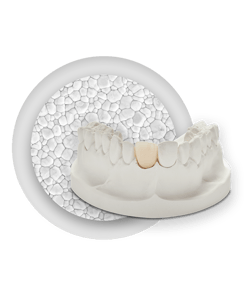Zirconia crowns have gained popularity over the past decade. Today’s patients request zirconia crowns over metal-based crowns because zirconia restorations provide strength and lifelike esthetics. Additionally, zirconia is highly durable that can withstand forceful chewing and grinding over an extended period. 
If properly maintained, zirconia restorations can last a patient’s lifetime. Because of its newness, some dentists refrain from using zirconia crowns or learning to properly place them into their patients’ mouths. This lack of experience can sometimes lead to ill-fitting crowns.
Dental crown fit issues are not something that you can ignore. Any problems with dental crowns must be addressed immediately for your patient's safety.
Because zirconia crowns are designed to help seal and protect your patient’s teeth from further damage, it is imperative that you know how to place a crown properly and how to adjust the fit of the crown should complications arise.
What can cause ill-fitting zirconia crowns?
- The dental crown was rushed. When crowns are rushed, errors occur, such as incorrect margins. Crowns cemented with an open margin allow entry or seepage of saliva and bacteria inside the crown, which may lead to decay and periodontal issues.
- The crown was not appropriately cemented. Clinicians must meticulously check the crown margins to avoid potential errors during cementation, such as a gap in the crown. This gap allows saliva and bacteria inside the crown, leading to tooth decay and infection.
- The impression was questionable. Air pockets, drag or pull marks, missing impression data, inaccurate marginal impressions, and poor impression material will all affect the quality of the impression.
- Preparation anomalies.

How to fix debonding complications
- If you find your zirconia crowns are debonding, try altering your cementation process. Most clinicians test out the fit of the zirconia crown in the patient’s mouth before cleaning the tooth with pumice.
- Next, decontaminate the intaglio surface of the zirconia restoration before you prepare it with a priming agent or adhesive if the zirconia crown does not have a built-in primer.
- Finally, cement the crown, tack the cure, and remove any excess cement.
Even though these are all standard procedures, clinicians sometimes fail to decontaminate the intaglio surface thoroughly, which causes the bonding process to fail. Because zirconium oxide bonds with phosphate groups, it’s critical to properly remove them so the oxide sites can bond successfully in the patient’s mouth.
Three ways to remove phosphate groups
- Sandblasting. Although sandblasting the internal surface with 50-micron diameter aluminum oxide is sometimes not recommended, most manufacturers recommend sandblasting the internal surface very lightly at low pressure. Always refer to the manufacturer’s recommendations before attempting this method.
- Sodium hypochlorite. The intaglio of the crown is wiped with gauze soaked in a 5% concentration of sodium hypochlorite or full hydrogen peroxide, which is removed by rinsing with water and air-drying the restoration.
- Ivoclean. Use a proprietary solution such as Ivoclean. Leave the solution on the crown for 20 seconds before rinsing. The crown is then air-dried and ready to bond.
Ensuring restorations don’t rock facial-lingually
Do you find the margins of zirconia crowns fit perfectly but that the crown rocks facial-lingually? This problem occurs more often than you’d think and takes longer to fit patients' zirconia crowns properly.
When the digital image of the patient’s tooth is constructed, any irregularities are removed as milled restorations have smooth surfaces internally and will not fit over irregularities or undercuts.
Usually, a die-spacer is used on conventional models, which creates a space of approximately 50-100 microns. When fabricating zirconia restorations, have your clinician ensure that the computer program is set to create well-fitting margins while specifying the size of the space between the fit surface and the prep site. This simple step replicates the function of a conventional die-spacer and will prevent zirconia crowns from rocking facial-lingually.
Ill-fitting crowns can lead to unhappy patients. If you ever experience fit issues with a zirconia crown, call our lab directly to discuss your specific case with our technical team. DDS Lab’s technical team is ready to help solve any issues regarding ill-fitting restorations and will work with your office to find the best solution.
Click here to schedule a consultation with our technical team ›

References:
https://www.dentalnegligenceteam.co.uk/blog/poorly-fitting-crowns/
https://www.smileconnectionsdental.com/blog/fix-dental-crowns-cerec/
https://www.ncbi.nlm.nih.gov/pmc/articles/PMC4026739/